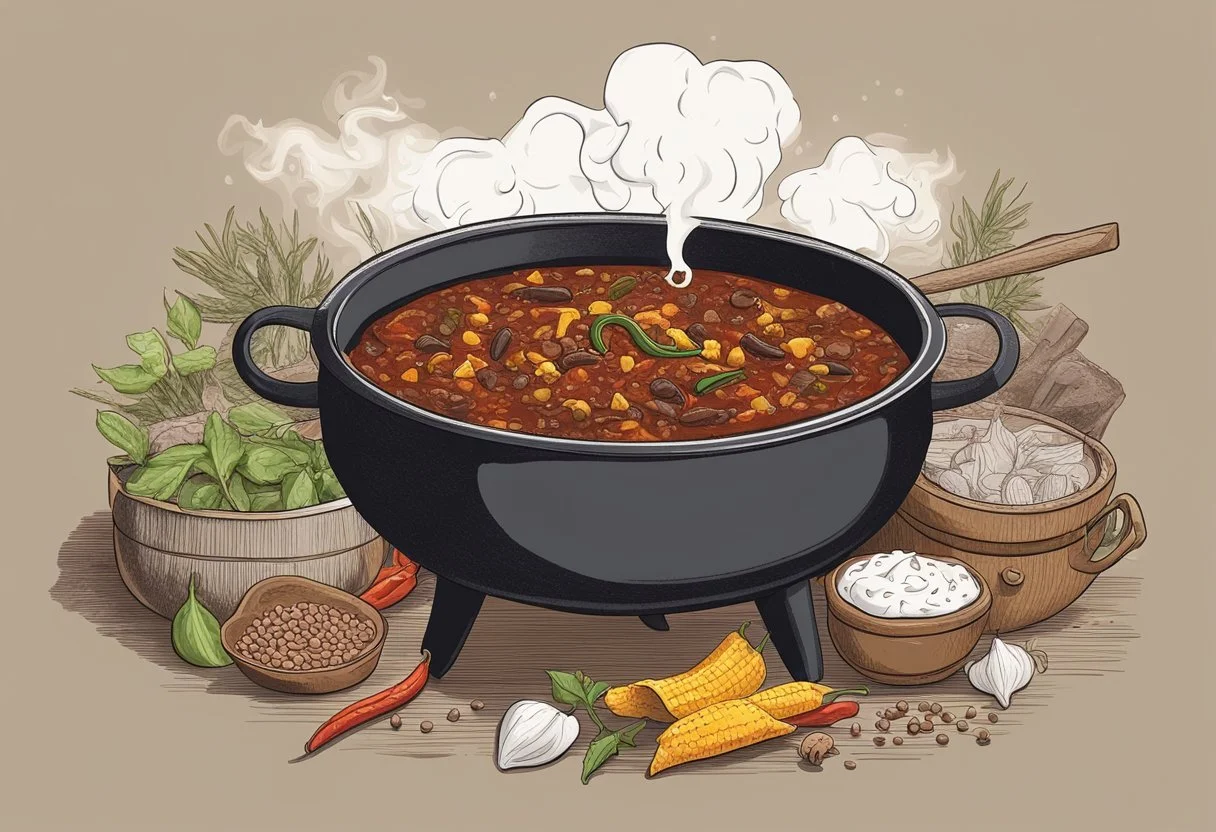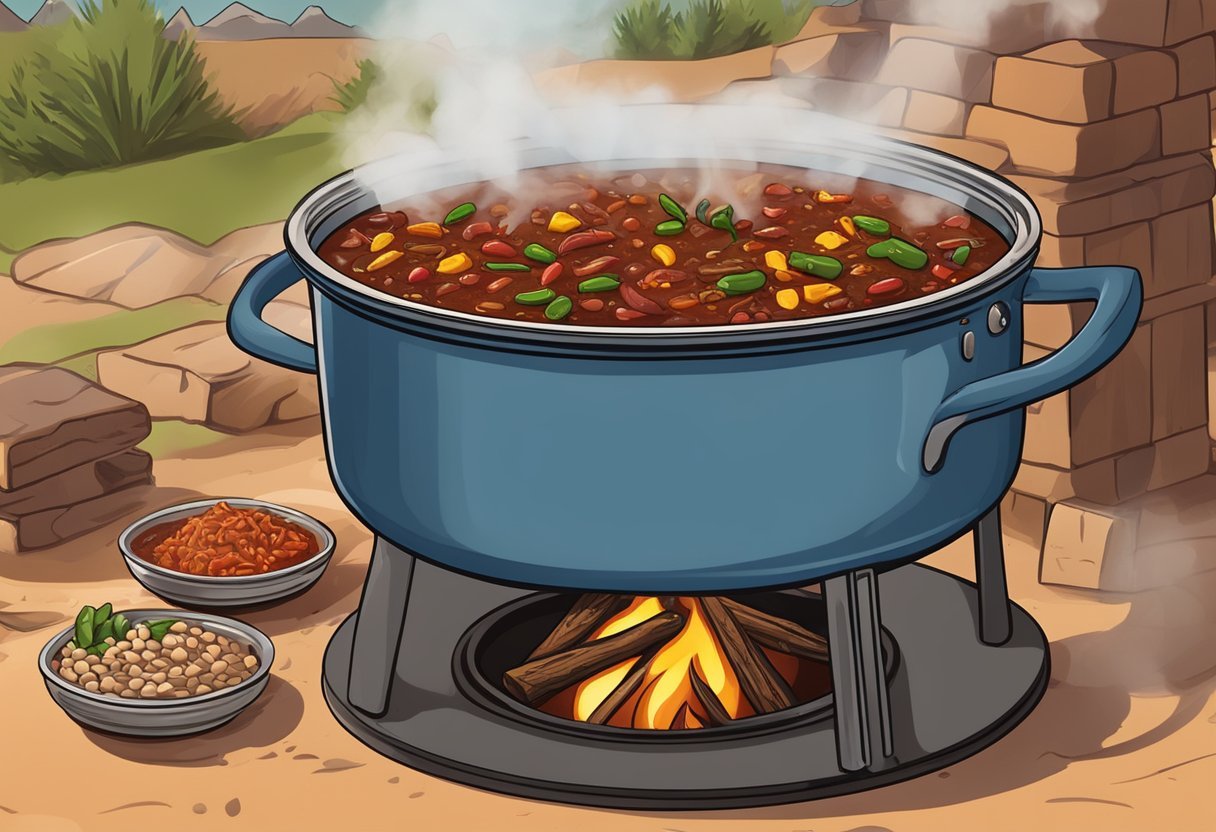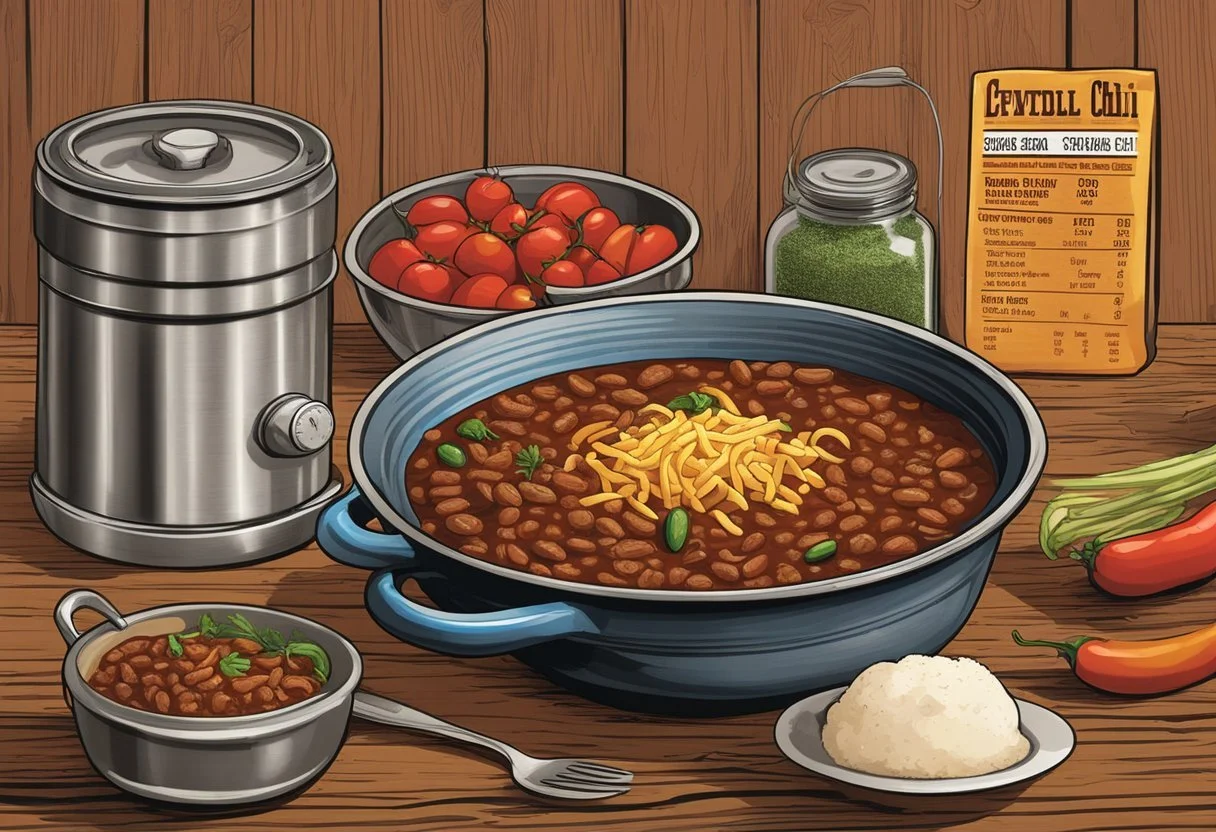Texas Cowboy Chili
Expert Tips for a Hearty, Authentic Flavor
Discover > Truly Texan > Texas Cowboy Chili
The rich tradition of Texas cowboy chili has long been a staple in the culinary culture of the Lone Star State. Born from the days of cowboys driving cattle across the state, this robust dish remains popular across generations and regions. A true Texas-style chili is recognized for its hearty ingredients, its bold flavors and, notably, the absence of beans.
When discussing the key elements of Texas cowboy chili, it's essential to address the foundation: the meat. Traditionally, cowboys utilized the resources at their disposal, often opting for beef, venison (What wine goes well with venison?), or other wild game. The meat is prepared by slow cooking in a blend of spices, tomatoes (What wine goes well with tomatoes?) minced garlic, and chilies, which allows for tender, flavorful results.
As chili connoisseurs know, there are many personal touches and variations that can be added to the recipe, but the essentials remain rooted in tradition. A well-crafted Texas cowboy chili offers a unique and satisfying eating experience, comfort food that proudly represents the culinary heritage of Texas.
History of Texas Cowboy Chili
Origins and Evolution
The origins of Texas cowboy chili recipe can be traced back to the mid-19th century, when Texan settlers combined simple, readily available ingredients to create a nourishing and flavorful dish. Originally, chili was made without beans and tomatoes, which were later introduced.
Over time, the cowboy chili recipe was modified and passed down from one generation to another, eventually resulting in new variations of the chili, each with a unique flavor profile. Some of the most popular changes include the addition of ground meat, beans, and tomatoes, while other recipes stick to the authentic tradition of the original chili con carne.
Cattle Drives and Chili
When cattle drives became widespread in the 1800s, chili significantly provided cowboys with a hearty and nutritious meal. The chili's simplicity medium high heat made it a perfect choice for cattle drives.
Key features of chili during cattle drives:
Long-lasting ingredients: Non-perishable ingredients such as dried chilies were used that could withstand long journeys and harsh conditions.
Easily rehydrated: Cowboys could rehydrate dried beef (or venison) and chilies by boiling them in water, making it an easy-to-prepare dish on the trail.
Nutrition: Rich in protein and calories, chili helped provide energy needed for the cowboys to endure the strenuous work and long days on the trail.
Flavor adaptability: Individual cowboys could adjust the seasoning of their chili according to their personal preferences, adding more or less heat depending on the chili powder, chilies and spices available.
Today, the tradition of Texas cowboy chili continues to be a beloved symbol of Texan cuisine. Situated between the authentic beginnings and contemporary interpretations, this dish offers a rich history that reflects Texas culinary culture and heritage.
Essential Ingredients
Meat Selection
When it comes to making an authentic Texas cowboy chili, your choice of meat is vital. Traditionally, chuck or brisket beef is the go-to option for this dish. However, you can also consider using other meats, such as bison (What wine goes well with bison?) or venison. Selecting a cut that's both lean and flavorful is a good idea, although many use ground beef. Lean ground beef is a less expensive cut and it cooks a lot quicker than sliced cuts.
Chili Spices and Seasonings
Creating the perfect blend of spices is at the heart of a great Texas cowboy chili. A combination of chili powder, cumin, dried ancho, and pasilla chiles is the foundation of the dish's distinctive flavor. To ensure a rich, complex taste, toast the whole chiles and cumin seeds (how long do cumin seeds last?) before grinding them.
Skip the lines and order your chili powder, cumin, dried ancho, and pasilla chiles online for a stress-free shopping experience!
The Role of Beans
In traditional Texas chili recipes, it's common to find them labeled as "no beans." Texans take pride in their meat-centric dish, so adding kidney beans (how long do kidney beans last?) is often frowned upon. However, just because kidney beans or pinto beans (how long does pinto beans last?) aren't a classic inclusion in Texas cowboy chili doesn't mean they can't be added to modern recipes. If you prefer a thicker, heartier chili, don't hesitate to add drained kidney beans, pinto beans or black beans (how long do black beans last?).
Tomatoes and Alternatives
When it comes to tomatoes, the debate is almost as contentious as the one surrounding beans. Some purists believe that no tomatoes should ever be added to a Texas chili recipe, claiming that the original dish was strictly meat, chiles, and beef broth (how long does beef broth last?). However, a modern chili recipe may include either crushed or diced tomatoes and tomato paste (how long does tomato paste last?) to achieve a thicker, richer sauce.
For those who prefer to stick to tradition with their chili recipe, a blend of chili powder, chiles, and a mix of beef broth and water can provide a suitable base for your chili instead. Alternatively, use a combination of diced tomatoes, stewed tomatoes, and chile-based ingredients to strike a balanced flavor.
Save time and effort by ordering beef broth, crushed or diced tomatoes, and tomato paste online!
Preparation Techniques
Meat Preparation
The most traditional and popular choices are beef and pork. Trimming the excess fat before cutting the meat into bite-sized cubes is important. This ensures great texture, without the chili becoming too greasy. Some cooks even opt to brown the meat before adding it to the pot, giving it richer flavors.
Cooking Styles
The cooking style for the Texas cowboy chili recipes mainly revolves around slow cooking methods. One traditional approach is to use a cast-iron Dutch oven or a slow cooker and cook on low, to ensure the flavors meld together and the meat becomes tender. For a hands-on approach, a cast-iron skillet can also be used over medium heat, stirring occasionally. These slow-cooking techniques allow the meat to absorb the spices and seasonings, resulting in a robust chili with a delightfully tender mouthfeel.
For the most extensive selection, I suggest buying a cast-iron Dutch oven or a slow cooker online!
Flavor Layering
Layering flavors is the key to a scrumptious Texas cowboy chili recipe. A combination of spices, seasonings, and sauces are used to give chili its distinct taste, along with salt and pepper.
Spices: A blend of spices forms the base layer for chili. Essential spices include:
Cumin
Chile powder
Paprika
Cayenne pepper
Seasonings: To add depth and complexity try these seasonings:
Garlic
Chopped Onions
Oregano
Brown sugar
Sauces: Lastly, sauces provide moisture and flavor. Some options are:
Tomato sauce
Crushed tomatoes
Beef broth
Beer
Worcestershire sauce (how long does worcestershire sauce last?)
When it comes to getting the best deals, buying cayenne pepper, brown sugar, and Worcestershire sauce online is the way to go!
Texas Chili Variations
Texas Red Chili
Texas Red Chili, also known as cowboy chili, is a classic version of Texas chili that highlights the deep, rich flavor of beef and spices. This type of chili consists of slow-cooked beef chunks, an array of chili peppers, spices like cumin and paprika, and a flavorful base that has been simmered for hours. Unlike some other chilis, Texas Red Chili is characterized by its lack of beans. Here's a list of ingredients:
Beef
Chili peppers
Spices
Tomatoes or tomato paste
Garlic
No-Bean Chili
Texans take great pride in their chili; many purists believe real Texas chili should be bean-free. In fact, the official chili of Texas, declared by the Texas State Legislature in 1977, specifically omits beans as an ingredient. When making a no-bean chili, the focus is on the meat, spices, and heat from chili peppers. It is often served as a main dish with accompaniments like cornbread, rice, or tortillas. Some no-bean ingredients include:
Ground or diced meat
Chili peppers
Spices
Onions
Tomato (optional)
Chili with Unique Twists
Innovative chefs and home cooks are always looking for ways to shake things up in the kitchen, and the traditional chili here is no exception. Some unique twists on Texas chili involve unconventional ingredients, cooking methods, or regional influences. Some cooks like to thicken chili before serving with flour or cornstarch (how long does cornstarch last?). A few examples include:
Adding chocolate or cocoa powder for depth of flavor
Incorporating uncommon meats like venison or bison
Cooking with various types of beer or brewed coffee
Blending in green or hatch chilies for added heat and complexity
Experimenting with chili recipe different chili powder and pastes or smoked peppers
Serving and Toppings
Traditional Accompaniments
When serving Texas cowboy chili, it's essential to provide traditional accompaniments that complement the dish. In general, most people serve this flavorful chili with cornbread on the side. Cornbread is delicious, and also soaks up any leftover chili in the bowl. Similarly, tortilla chips (how long do tortilla chips last?) and grated cheddar cheese are popular accompaniments.
Another popular accompaniment is a bowl of warm, cooked white rice or Mexican-style rice. This pairing helps create a satisfying and filling meal as it complements the hearty texture of the chili.
Garnishing with Toppings
To elevate the Texas cowboy chili experience, offer a variety of toppings for your guests to customize their dish. The following toppings work well together and allow each person to tailor their meal to their preferences:
Sour cream: A dollop of sour cream adds creaminess to the chili and helps to tame the spiciness.
Cheddar cheese: A generous sprinkle of grated cheddar cheese adds richness and saltiness.
Cilantro: Finely chopped cilantro not only adds a pop of color but also provides a fresh and fragrant finish.
Jalapeños: For those who prefer spicier chili, offer sliced jalapeños as an optional topping to add a kick of heat. Don't forget to offer salt and pepper to your guests.
Nutritional Information
Caloric Consideration
Texas cowboy chili, a hearty and flavorful dish, contains a variety of ingredients that contribute to its nutritional value. A typical serving of this dish provides approximately 350-450 calories. The primary sources of calories in cowboy chili include the meat (usually beef), beans, and added fats like oil or butter used in cooking.
Macro and Micronutrients
Carbohydrates: A serving of cowboy chili contains around 30-40g of carbohydrates, with the majority coming from kidney beans and vegetables. Kidney beans are a great source of complex carbohydrates and dietary fiber, which aids in digestion and promotes satiety.
Protein: The primary protein source in this dish is lean beef or ground beef, which provides approximately 25-30g of protein per serving. Lean and ground beef protein is essential for building and maintaining muscle mass, as well as supporting various bodily functions.
Fat: Depending on the type and amount of fat used in cooking, a serving of Texas cowboy chili contains around 15-20g of fat, with a mix of both saturated and unsaturated fats. Fat is necessary to provide energy and support cell growth.
Aside from these macronutrients, cowboy chili also contains several important micronutrients:
Tips and Tricks
Chili Storage and Reheating
Chili often tastes better the next day, as the flavors have time to meld and deepen. To store and reheat your Texas cowboy chili effectively, follow these steps:
Cool before storing: Let the chili cool to room temperature before transferring it to an airtight container.
Refrigerate or freeze: Chili can be safely stored in the refrigerator for three to four days or the freezer for up to three months.
Reheat slowly: When reheating the chili, use low heat on the stovetop or a low setting on the microwave, stirring occasionally to ensure even heating.
Frequently Asked Questions
How do I cook the best chili ever?
Brown your meat, onions, and garlic in a large pot or Dutch oven.
Add in the other ingredients except for the masa harina (how long does masa harina last?). This includes the broth, beans, tomatoes, chili peppers, and spices.
Allow the chili to simmer over low heat for at least an hour, occasionally stirring to prevent sticking.
To thicken the chili, create a slurry by whisking together masa harina with some water or beef broth. Gradually pour the slurry into your simmering chili and cook it for an additional 15-20 minutes, until the desired thickness is achieved.
What is the best way to serve the Texas Cowboy Chili recipe?
Serve the chili hot, garnished with toppings such as sour cream, grated cheese, chopped green onions, and freshly chopped cilantro. You may also serve warm bowl of it with a side of cornbread, tortilla chips, or warm tortillas.
How long can the chili be stored?
Store leftover chili in an airtight container in the refrigerator for up to 4-5 days. To store it longer, you can freeze the chili for up to 3 months. Simply reheat over low heat before serving.
Are there any variations to the traditional recipe?
Yes, you can try experimenting with different protein sources like pork, chicken ground turkey, or even vegetarian options like tofu (how long does tofu last?) or seitan (What wine goes well with seitan?). You may also choose to incorporate additional vegetables like bell peppers and corn for added flavor and variety.





